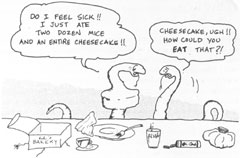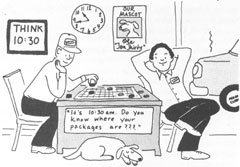Why do Clocks run clockwise? (15 page)
Read Why do Clocks run clockwise? Online
Authors: David Feldman

Foil starts as a large block of solid aluminum. The block is rolled like a pie crust until it becomes one long, thin, continuous sheet.
The dissimilar finishes of Reynolds Wrap are the result rather than the intention of its manufacturing process. Martin explains that “In the final rolling step, two layers of aluminum foil are passed through the rolling mill at the same time. The side coming in contact with the mill’s highly polished steel rollers becomes shiny. The other side, not coming in contact with the heavy roller, comes out with a matte finish.”
Submitted by Frank Russell, of Columbia, Missouri
.
102 / DAVID FELDMAN

Why Do Superficial Paper Cuts Tend to Hurt More
Than Grosser Cuts?
Perhaps paper cuts hurt more because they are so emotionally maddening. How can such a trivial little cut, sometimes without a hint of blood, cause such pain?
The sensory nerve endings are located close to the skin surface, and the hands, where most paper cuts occur, contain more nerve endings than almost any other area of the body. Dr. John Cook, of the Georgia Dermatology and Skin Cancer Clinic, adds that a trivial laceration such as a paper cut creates the worst of both worlds: “It irritates these nerve endings but doesn’t damage them very much.”
Damaged nerve endings can lead to more serious complications, but sometimes to less pain than paper cuts.
Dr. Cook and Dr. Elliot, of the American Dermatological WHY DO CLOCKS RUN CLOCKWISE? / 103
Association, also mentioned that most patients tend not to treat paper cuts as they would grosser ones. After any kind of cut, the skin starts drying and pulling apart, exposing nerve endings. Cuts are also exposed to foreign substances, such as soap, liquids, perspiration, and dirt. Putting a bandage over a paper cut will not make it heal faster, necessarily, but if the cut stays moist, it won’t hurt as much.
Why Does the Brightest Setting of a Three-Way
Light Bulb Always Burn Out First?
As we sit typing this in the light of a General Electric 50/200/250-watt three-way light bulb, having experienced this plight many a time in the past, we took a personal interest in solving this Imponderable. If you have read the following Imponderable (and shame on you if you are reading out of order), you have already figured out the answer. When you can no longer get the 250-watt light, the reason is that the 200-watt filament has burnt out. All that is left is the 50-watt filament, lovely for helping plants grow, but hardly sufficient illumination in which to create literary masterpieces.
However, the higher-wattage filament doesn’t
necessarily
burn out first. It does have a shorter rated life than the low-wattage filament. General Electric’s research has shown that because the lower filament is often used as a night light or background light, it tends to get more use than the higher-wattage filament, so it is intentionally designed to have a longer life.
Submitted by Tom O’Brien, of Los Angeles, California
.
104 / DAVID FELDMAN
How Do Three-Way Light Bulbs Work? How Do
the Bulbs “Know” at Which Intensity to Shine?
Each three-way light bulb contains two filaments. Let’s take as an example the popular 50/100/150-watt three-way bulb. When you turn the switch to the first setting, the lower wattage (50-watt) filament lights. When you turn to the next setting, the 100-watt filament lights and the 50-watt filament turns off. When you turn the switch for the third time, both the 50-and the 100-watt filaments light. This explains why the highest wattage rating for a three-way bulb is always the sum of the two lower wattage figures.
James Jensen, of the General Electric Lighting Business Group, is quick to explain that three-ways will work only in sockets designed to accept this type of bulb. While the three-way bulb, like conventional bulbs, makes contact in the socket through its screw shell and through an eyelet contact at the bottom of the base, it also contains a third feature. Says Jensen: “In addition, there is a contact ring surrounding the eyelet. This ring contacts a small post contact in the socket. Sometimes, a three-way bulb will flicker or fail to light on all settings. This is often due to poor (or no) contact in the socket. Sometimes merely tightening the bulb in the socket will remedy this.”
Submitted by Elaine Murray, of Los Gatos, California
.
WHY DO CLOCKS RUN CLOCKWISE? / 105

Why Do Snakes Dart Out Their Tongues?
Although snake watchers at zoos love to see the reptiles flick their tongues, imagining they are ready to pounce on some unsuspecting prey, the tongues are perfectly harmless. Snakes don’t sting or use their forked tongues as weapons.
The tongue is actually an invaluable sensory organ for the snake.
It enables the reptile to troll for food (just as a fisherman sticks his line out in the water and hopes for the best), while feeling its way over the ground. It does this by bringing in bits of organic matter that it can smell or taste, alerting it to a potential food source. Some evidence suggests that a snake’s tongue is equally sensitive to sound vibrations, warning it of potential prey or predators.
106 / DAVID FELDMAN
Where Do They Get That Organ Music in Skating
Rinks?
As we discussed in our first volume of Imponderables, skaters are not allowed to use music with vocals in competitions, and we explained some of the reasons why that music sounds so awful. The inevitable follow-up question: what about the music in ice and roller skating rinks?
Chances are very, very good that any organ music you hear in skating rinks comes from a company called Rinx Records, the only known source for tempo organ music. Competitive skaters need all-instrumental music of specific lengths (usually three or four minutes, exactly) for competitions and achievement tests. Not only do these songs need to be an exact length, but many need to be an exact number of beats per minute. Rinx Records, for example, provide waltzes with 108, 120, and 138 beats per minute. The records must have a strong beat so that skaters can synchronize their movements with music often piped through horrendous sound systems.
Rinx Records was founded in 1950, in Denver, Colorado, by Fred Bergen, a man who not only was involved in skating, but was an organist who played on many records. In 1968, Bergen sold Rinx Records to Dominic Cangelosi, who still operates the business from the roller rink he owns. Cangelosi has played keyboards on all of the records he has released since 1968. His music is heard throughout the world, but like the baseball stadium organist, he labors in semiobscurity, unmolested by rabid fans on the street.
Rinx is a nice business. Although a few other individuals besides Cangelosi market tapes, Cangelosi has the record end of the field sewn up. He has a big market, with a mailing list of more than five thousand customers, including not only rinks but skating instructors and individual skaters as well. Ice skating and roller skating share many of the same tempos (though some ice skating music is much faster), so Rinx sells to both markets. In WHY DO CLOCKS RUN CLOCKWISE? / 107
all, Rinx has more than thirteen hundred
different
records in stock, on seven-inch 45 rpm. If your heart prompts, you can find out more about Rinx Records by contacting Dominic Cangelosi at: P. O. Box 6607, Burbank, CA 91510.
Although Rinx’s variety of organ music is associated with bygone days, Cangelosi has tried to spice up his arrangements with synthes-izers, pianos, and electronic and Hammond organs in addition to the traditional acoustic and pipe organs. On some records, he adds guitar, drums, or other accompaniment. Cangelosi also “covers”
popular songs, for which he pays a fee to ASCAP or BMI. Rink operators likewise have to pay a nominal fee to these licensing organizations for playing contemporary songs in their rinks.
George Pickard, executive director of the Roller Skating Rink Operators Association, says that most rinks have abandoned old-fashioned music for rock and disco. But many have special adult sessions that use Rinx and other more traditional records. There are even a few rinks that still have live organ music, the last echo of bygone days.
Submitted by Gail Lee, of Los Angeles, California. Thanks also to:
Joy Renee Grieco, of Park Ridge, New Jersey
.
108 / DAVID FELDMAN

What Do Federal Express Delivery People Do After
10:30 A.M.?
Federal Express is justly famous for its pledge to deliver Priority One packages before 10:30 A.M. the next business day. What, then, do delivery people do after the last priority package is delivered? Take a siesta? Smoke cigars? Play poker with U.S. Post Office employees who haven’t delivered their first-class mail yet?
Actually, Federal Express keeps its employees hopping all day long. In some cities, packages are delivered as early as 7:30 A.M.
(The pickup and delivery cycles of packages tend to be earlier in the West, because
all
packages are routed through Federal Express headquarters in Memphis, Tennessee prior to shipment to their eventual destinations.) Before any packages WHY DO CLOCKS RUN CLOCKWISE? / 109
can be delivered, they must be sorted by routes; in smaller stations, the courier often does the sorting himself.
After all Priority One packages are delivered, the courier tries to drop off all second-day deliveries before noon. If he succeeds, he is likely to take a lunch break around midday.
After lunch, the pickup cycle begins. By the time the courier has gathered all the incoming packages, he has worked a full day. If there is any spare time at all, paper work has a way of filling it.
In large stations, the process of sorting routes, delivering Priority One packages, delivering second-day packages, picking up all packages, and filling out paper work can consume more than eight hours.
For this reason, about 25 percent of all Federal Express employees are part-timers, often used for sorting packages for delivery by couriers. When a Federal Express courier drops off his last Priority One package before the 10:30 A.M. deadline, his workday has just begun.
Submitted by Merle Pollis, of Cleveland, Ohio
.
110 / DAVID FELDMAN
Why Do So Many Mass Mailers Use Return
Envelopes With Windows?
It’s easy to figure out why many mass mailers (such as utilities or credit card companies) use window envelopes for the bills they send to you. Bills are prepared by computers and are stuffed into envelopes by inserting machines. The window eliminates the costly process of addressing each envelope separately.
But why the window on the return envelope? Couldn’t the companies simply preprint their address, avoiding the problem of customers inserting the reply portion of the statement upside down or wrong side out?
There is a good reason for window reply envelopes. Many large companies use various geographical locations for receiving remit-tances. The window envelope saves the company the cost of printing several different addresses on reply envelopes.
Although the dire warnings on the back or flap of envelopes have almost eliminated the problem of incorrectly stuffed reply stubs, Pavey Envelope and Tag Corporation, of Jersey City, New Jersey, has recently developed the idea of clipping a corner on the return stub and gluing a corner of the envelope so that the stub can be inserted only one way—the correct way.